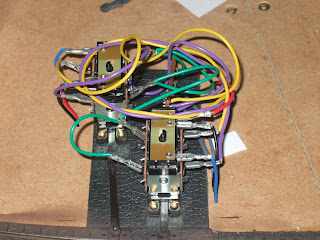Starting from scratch

No, don't read too much into that title, it just means track laying is complete though ballasting is still needed on the yard tracks. It actually links to the fact that I am now starting to slowly add buildings, the first being a scratchbuilt building to cover up some point motors. The 'Rats Nest' to cover up. So I have made a template building out of plasticard ( .30 thou from work though any will probably do). This so far is roofless and has a slot in the wall facing the tract to allow the point rodding to go through. The basic plasticard template Now as I said, this is just a temporary mock up, the final will be made either from slaters, south eastern finecast or wills stone sheeting, now as can be seen already, even without a roof it looks much better, so imagine what the final result may look like, and then tell me as I still haven't fully decided what the building will be, though a water tower is likely at this point in time. But now I have s...





